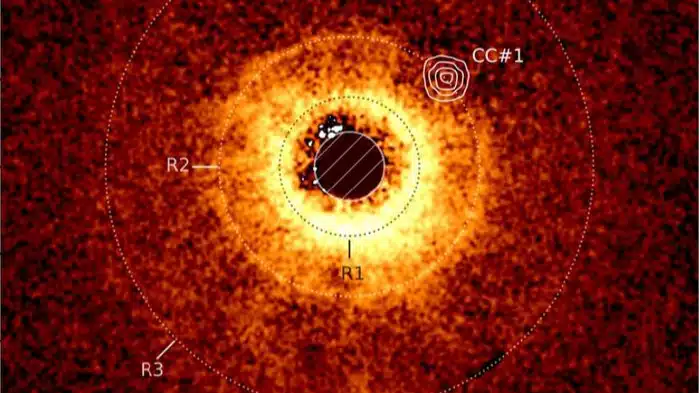James Webb Telescope Achieves Milestone with First Direct Image Capture

The James Webb Space Telescope (JWST) has achieved a significant milestone by capturing its first direct image of a newly discovered exoplanet. This groundbreaking observation reveals TWA 7 b, a Saturn-mass planet orbiting the young star TWA 7, located relatively close to Earth. With a mass approximately 0.3 times that of Jupiter, TWA 7 b is now recognized as the smallest planet ever imaged directly, marking a pivotal moment in the study of exoplanets, which have mostly been detected through indirect methods.
Detecting a Hidden World
In a study published in the journal Nature, astronomers detailed how the JWST team focused on TWA 7 due to its nearly face-on dusty disk, which displays distinct ring structures. Utilizing the Mid-Infrared Instrument (MIRI) equipped with a coronagraph, the team successfully blocked the star’s bright light, allowing them to identify the faint planet. After analyzing the data, they discovered a faint infrared point source located about 1.5 arcseconds from TWA 7, equivalent to roughly 50 times the distance from the Earth to the Sun.
This point source is situated within a gap of the star’s second dust ring. Its brightness and color correspond with theoretical predictions for a young, cold planet of approximately Saturn’s mass. The presence of this object appears to be creating a gap in the dust ring, consistent with the behavior of an orbiting planet. The astronomers ruled out alternative explanations, such as the possibility of a background star, confirming that the signal is most accurately attributed to a planet.
A Step Toward Smaller Worlds
The discovery of TWA 7 b, with its Saturn-like mass, represents a significant leap in the capability of the JWST. This planet is about ten times less massive than any previously imaged exoplanet, demonstrating that the telescope can now capture images of much smaller worlds. Scientists believe that the JWST may eventually be able to detect planets with masses as low as 10% of Jupiter’s, inching closer to the size of Earth.
This breakthrough is seen as a crucial step toward imaging terrestrial planets in the future. Astronomers anticipate that upcoming observatories will greatly enhance the ability to directly image Earth-sized planets. Plans for next-generation telescopes, both terrestrial and space-based, are underway, featuring even more advanced coronagraphs designed to search for the first direct images of Earth analogues.
Implications for Future Research
The successful imaging of TWA 7 b opens new avenues for exoplanet research and exploration. The ability to directly observe smaller planets could lead to a better understanding of their atmospheres, compositions, and potential habitability. As technology advances, astronomers are optimistic about the prospects of discovering more Earth-like planets, which could provide insights into the conditions necessary for life beyond our solar system.
The JWST’s capabilities signify a transformative era in astronomy, where direct imaging of distant worlds becomes a reality. This achievement not only enhances our knowledge of planetary systems but also fuels the quest to find life elsewhere in the universe. As researchers continue to analyze the data from JWST, the excitement surrounding the potential for future discoveries remains palpable.
Observer Voice is the one stop site for National, International news, Sports, Editor’s Choice, Art/culture contents, Quotes and much more. We also cover historical contents. Historical contents includes World History, Indian History, and what happened today. The website also covers Entertainment across the India and World.

